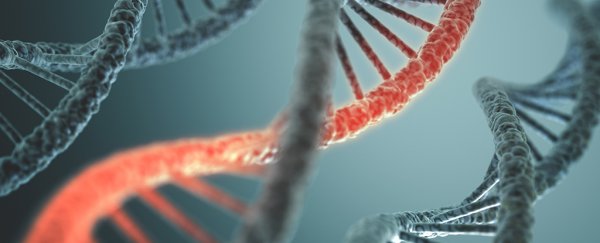Before there was life, ribonucleic acid (RNA) ruled the primordial soup. Or so the story goes, according to what's known as the RNA World hypothesis. But it seems we may have been too hasty in leaving out RNA's more complex cousin, deoxyribonucleic acid (DNA).
Chemists from the UK and the US have shown how both molecules could have formed under conditions likely to have been present on ancient Earth. This discovery could force a rethink on leading models of life's origins.
Elaborating on an earlier study that demonstrated a method for building chains of nucleic acid in a pre-biotic environment, the team has shown how RNA could be converted into components of the DNA molecule in a few easy steps - without any need for enzymes.
"These new findings suggest that it may not be reasonable for chemists to be so heavily guided by the RNA World hypothesis in investigating the origins of life on Earth," says Ramanarayanan Krishnamurthy from the US-based Scripps Research Institute.
For nearly half a century, biologists have been gaining confidence in models that claim the chemical machinery making up the first cells had its roots in RNA-based chemical reactions.
At first glance, it's a solid choice. Modern biochemistry can be boiled down to interactions between DNA, RNA, and proteins.
RNA's simpler structure and talent for mechanical labour gives it an edge in hypotheses suggesting the first biochemical reactions were predominantly governed by a single versatile molecule.
Not only can it do an adequate job of both templating and building, chemists are finding a variety of potential methods for growing RNA using ingredient lists of simpler organic compounds.
As convincing as it sounds though, the RNA World hypothesis isn't the only horse in the race. Proteins might have also churned out copies on their own, for example.
But without a straightforward way to get DNA from simpler precursors, few researchers have championed DNA's role in life's prototype reactions.
Krishnamurthy and his colleagues have suspected for some time that the RNA World story is a little more involved than it would first appear.
For one thing, evolving pure RNA systems into DNA-based ones would probably require some sort of hand-over period where both molecules were performing similar templating tasks.
Several years ago, the researchers showed that such hybrid molecules weren't as stable as pure RNA and DNA strands. This raises an interesting question – why would delicate hybrid mixtures evolve from more robust RNA-based ones?
One answer is that there was no pure RNA world to begin with, just a shaky mix of the two molecules competing for supremacy, until a pure DNA system won out.
"There is the beginning of a realisation in the field that RNA and DNA could have been mixed together initially but later separated according to the things they do best," Krishnamurthy says.
All well and good, but where did this wealth of DNA molecules come from? Now, Krishnamurthy has an answer in the form of a sulphurous chemical called thiouridine.
Already implicated as a possible precursor to RNA, the team demonstrated how the compound could potentially react in several stages to form deoxyadenosine – the sugary backbone of the DNA molecule joined to one of the bases of its genetic code.
Alternatively, a similar process could churn out its chemical relative, deoxyribose.
Showing how a process could have happened isn't the same as proving it did take place, though.
But knowing it wouldn't take much to turn RNA into DNA might at least give it a seat at the table when it comes to solving some of the big problems with the RNA World hypothesis.
This research was published in Nature Chemistry.
